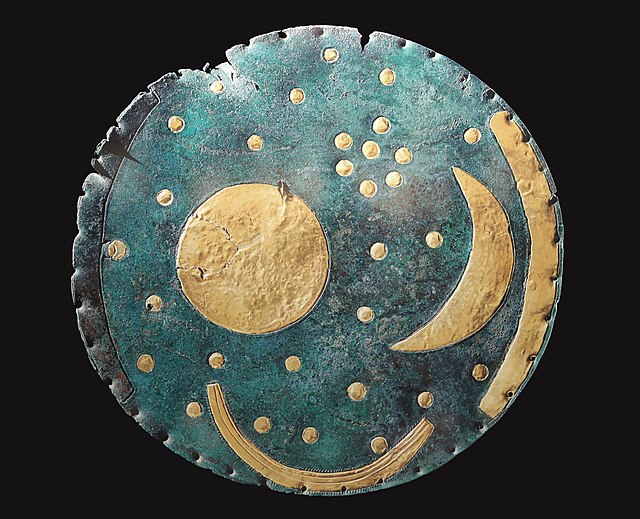Astronomy is the oldest of the natural sciences, dating back to antiquity, with its origins in the religious, mythological, cosmological, calendrical, and astrological beliefs and practices of prehistory: vestiges of these are still found in astrology, a discipline long interwoven with public and governmental astronomy. It was not completely separated in Europe during the Copernican Revolution starting in 1543. In some cultures, astronomical data was used for astrological prognostication.
The Northern Hemisphere page from Johann Bayer's 1661 edition of Uranometria - the first atlas to have star charts covering the entire celestial sphere
Southern Hemisphere
Sunset at the equinox from the prehistoric site of Pizzo Vento at Fondachelli Fantina, Sicily
The Nebra sky disk, Germany, 1800 - 1600 BC
Archaeoastronomy is the interdisciplinary or multidisciplinary study of how people in the past "have understood the phenomena in the sky, how they used these phenomena and what role the sky played in their cultures". Clive Ruggles argues it is misleading to consider archaeoastronomy to be the study of ancient astronomy, as modern astronomy is a scientific discipline, while archaeoastronomy considers symbolically rich cultural interpretations of phenomena in the sky by other cultures. It is often twinned with ethnoastronomy, the anthropological study of skywatching in contemporary societies. Archaeoastronomy is also closely associated with historical astronomy, the use of historical records of heavenly events to answer astronomical problems and the history of astronomy, which uses written records to evaluate past astronomical practice.
The rising Sun illuminates the inner chamber of Newgrange, Ireland, only at the winter solstice.
The sunset at the equinox seen from the prehistoric site of Pizzo Vento at Fondachelli Fantina, Sicily
Early archaeoastronomers surveyed Megalithic constructs in the British Isles, at sites like Auglish in County Londonderry, in an attempt to find statistical patterns.
It has been proposed that Maya sites such as Uxmal were built in accordance with astronomical alignments.







